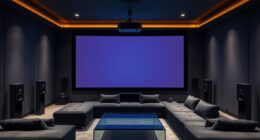To analyze your new restaurant’s break-even point, first identify your fixed costs like rent, insurance, and salaries, and calculate your variable costs per dish, such as ingredients and hourly wages. Next, determine your contribution margin per unit by subtracting variable costs from your menu prices. Dividing fixed costs by this margin gives your minimum sales units to cover expenses. Understanding these figures helps you set realistic sales goals and optimize pricing strategies, allowing your business to thrive.
Key Takeaways
- Calculate total fixed costs such as rent, salaries, and utilities to establish baseline expenses.
- Determine variable costs per unit, including food ingredients and hourly wages, for accurate contribution margin calculation.
- Use the formula: Break-Even Units = Fixed Costs / (Selling Price – Variable Cost per Unit).
- Analyze contribution margin ratios to set appropriate menu pricing that covers costs and supports profitability.
- Regularly review sales performance and costs to adjust strategies and ensure the break-even point is met or exceeded.
Understanding Fixed and Variable Costs in a Restaurant
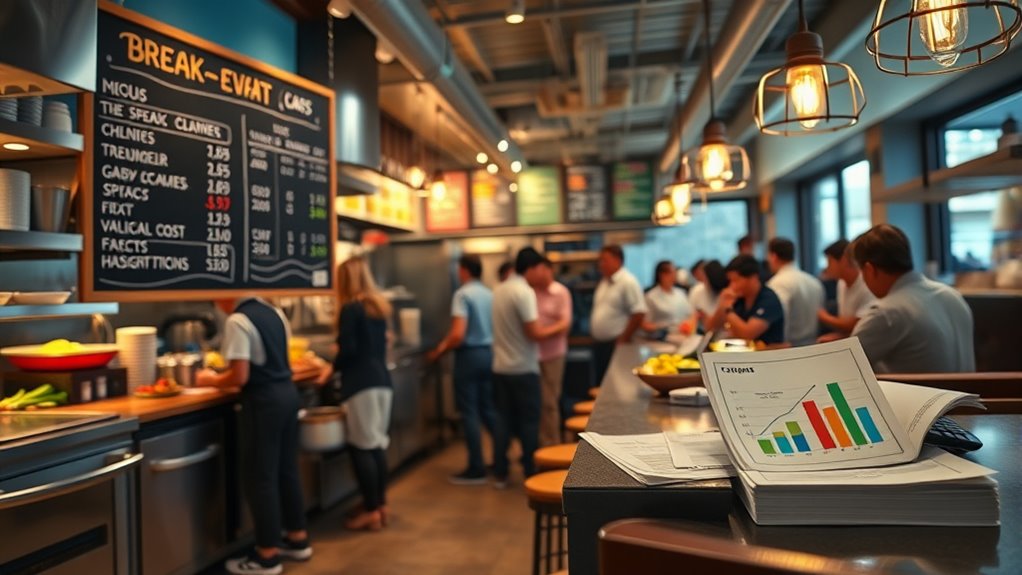
Understanding fixed and variable costs is essential for managing a restaurant’s finances effectively. Fixed costs stay the same regardless of how many customers you serve, like rent, insurance, and salaries of full-time staff. These expenses must be paid whether your restaurant is busy or slow. Variable costs, on the other hand, fluctuate with your sales volume. Food ingredients, beverages, and hourly wages are good examples—they increase as you serve more customers and decrease when sales are low. Knowing the difference helps you control expenses and set realistic sales goals. It also allows you to determine how many sales you need to cover your costs and start making a profit. Managing these costs carefully is key to ensuring your restaurant’s financial health and sustainability. Incorporating cost control strategies can further optimize your financial management efforts.
Calculating the Break-Even Point: Key Formula and Components
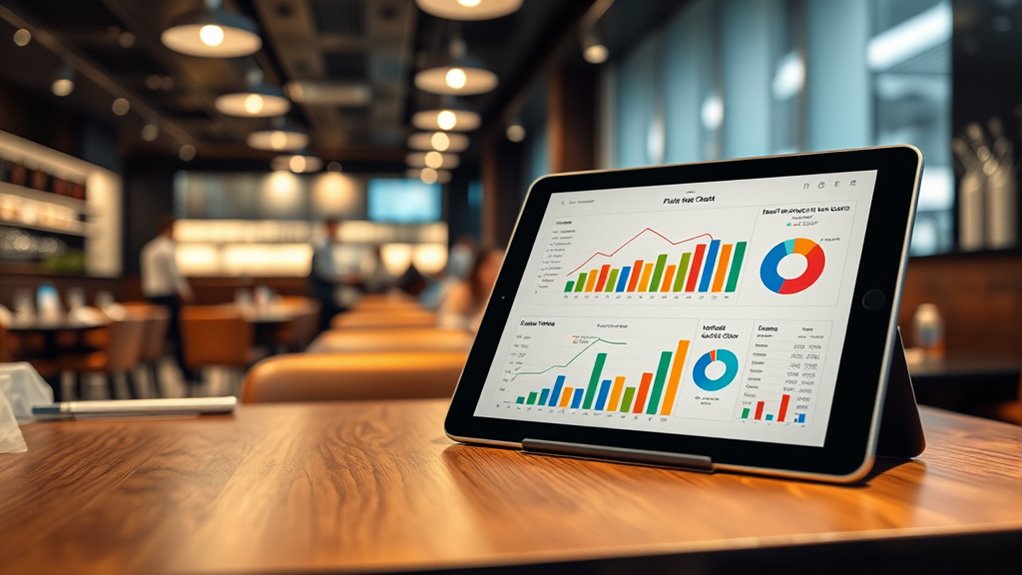
To calculate your break-even point, you’ll need to understand your fixed and variable costs, which form the foundation of the analysis. Next, you’ll determine your contribution margin, showing how much each sale contributes to covering fixed costs. Finally, you’ll use the break-even formula, breaking down its components to find the exact sales volume needed to avoid losses. Incorporating cost analysis ensures a comprehensive understanding of your expenses and profitability.
Fixed and Variable Costs
Fixed and variable costs are essential components when calculating the break-even point, as they directly influence your sales volume needed to cover expenses. Fixed costs remain constant regardless of your sales, including rent, salaries, and insurance. Variable costs fluctuate with your sales volume, such as food ingredients, beverages, and hourly wages. Understanding these costs helps you determine how much you need to generate in revenue to break even. Fixed costs must be covered regardless of sales, while variable costs increase with each sale. By accurately identifying and managing both types of costs, you can better forecast your break-even point, set realistic sales targets, and develop strategies to improve profitability. Knowing your costs inside out is vital for making informed decisions early on. Additionally, implementing cost control measures can help optimize your expenses and improve your overall financial health.
Contribution Margin Calculation
Calculating the break-even point requires more than just knowing your fixed and variable costs; it hinges on understanding how much profit each sale contributes toward covering those costs. This is where the contribution margin comes in. It represents the amount from each sale that goes toward paying fixed costs after covering variable expenses. To calculate it, subtract your variable costs per unit from the selling price per unit. Here’s a quick breakdown:
| Item | Calculation |
|---|---|
| Contribution Margin per Unit | Selling Price – Variable Cost per Unit |
| Contribution Margin Ratio | Contribution Margin per Unit / Selling Price |
Knowing these figures helps you determine how many units you need to sell to break even, providing clarity for your pricing and sales strategies. Additionally, understanding the home furnishings can influence customer preferences and spending habits, which is important for setting realistic sales targets.
Break-Even Formula Breakdown
Understanding the break-even formula is essential because it directly shows how many units you need to sell to cover all your costs. The basic formula is: Break-Even Point (units) = Fixed Costs / Contribution Margin per Unit. Fixed costs include rent, salaries, and utilities that stay constant regardless of sales volume. The contribution margin per unit is the selling price minus variable costs per unit, representing how much each sale contributes toward fixed costs. By dividing fixed costs by the contribution margin, you determine the minimum number of units you must sell to avoid losing money. This breakdown simplifies your financial planning, allowing you to set realistic sales targets and understand how changes in costs or pricing impact your profitability. Additionally, understanding popular juice brands and their health-focused options can help inform menu offerings and marketing strategies for new restaurant ventures.
Estimating Your Restaurant’s Fixed Expenses
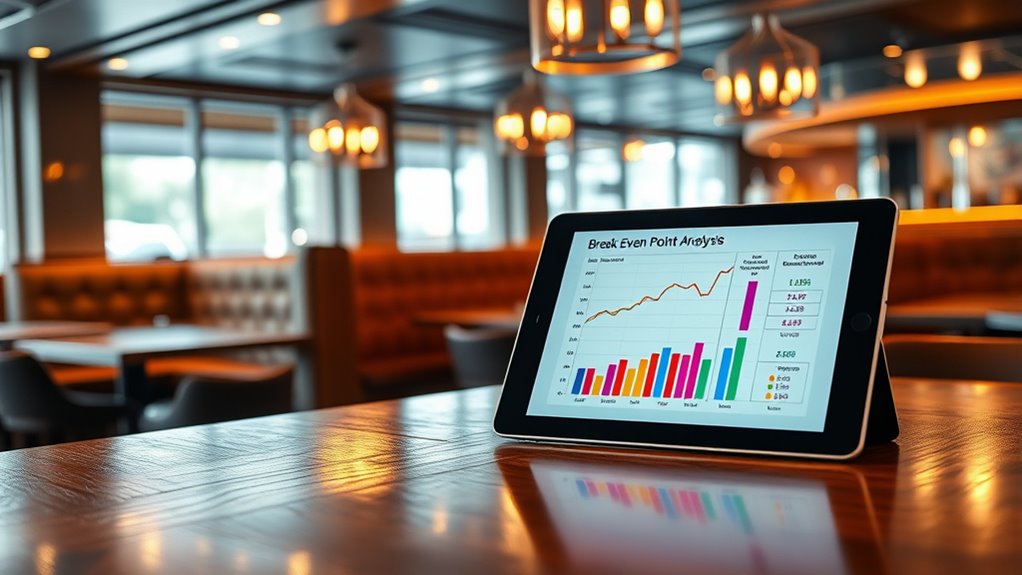
Estimating your restaurant’s fixed expenses is a critical step in determining your break-even point. Fixed expenses stay constant regardless of sales volume, so accurately identifying them is essential. Begin by listing all regular costs, such as rent or mortgage payments, insurance, property taxes, and salaries of full-time staff. Don’t forget to include utilities like water, electricity, and internet, which are often fixed monthly expenses. Consider maintenance costs, licenses, permits, and administrative expenses as well. Be thorough—missing any fixed cost can lead to an inaccurate break-even analysis. Keep detailed records of past bills and contracts to guarantee your estimates are realistic. Additionally, understanding your cost structure helps in making informed pricing and operational decisions. By precisely calculating these fixed costs, you’ll better understand how much revenue you need to cover expenses and reach profitability.
Determining Variable Costs per Dish or Service
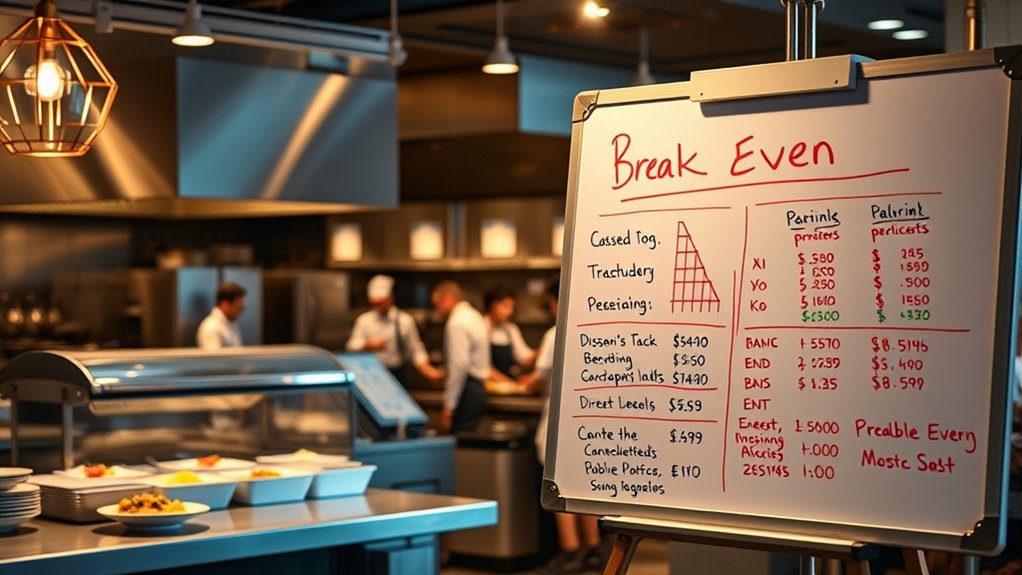
Ever wondered how much each dish truly costs to make? To determine your variable costs per dish, start by listing all ingredients required for each menu item. Track the purchase price of each ingredient and figure out how much of it is used per dish. Include other direct costs like portioning supplies or garnishes. Don’t forget to account for any cooking fuel, electricity, or water directly tied to preparing that dish. Add these costs together and divide by the number of servings they produce. This gives you the variable cost per dish. Knowing this number helps you set menu prices that cover costs and ensure profitability. Keep your calculations accurate and updated as ingredient prices fluctuate to maintain reliable cost estimates. Additionally, understanding water usage in food preparation can help optimize resource management and reduce costs.
Setting Realistic Sales Targets to Reach Break-Even
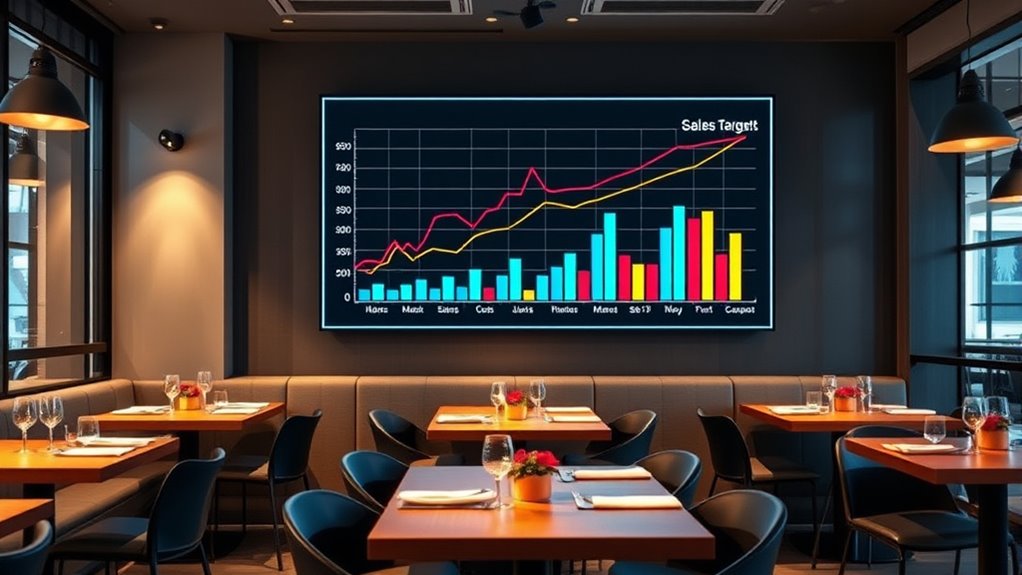
Setting realistic sales targets is essential for reaching your break-even point and ensuring your business stays profitable. To do this, analyze your fixed costs and determine the sales volume needed to cover these expenses. Avoid setting overly optimistic goals that may be unattainable; instead, base targets on thorough market research and historical data. Break down your sales goals into daily, weekly, or monthly benchmarks to track progress accurately. Consider seasonal fluctuations and local demand to adjust your targets accordingly. Regularly review your sales performance against these goals, and be prepared to modify your strategies if you’re falling short. Realistic targets motivate your team and keep your financial planning grounded, helping you stay on track toward profitability. Incorporating data from best airless paint sprayers can provide insights into efficient project planning and resource allocation, which are also crucial for achieving sales and operational goals.
Using Break-Even Analysis to Make Informed Pricing Decisions

Once you’ve established realistic sales targets, you can use break-even analysis to inform your pricing strategies. By understanding your fixed and variable costs, you can determine the minimum price needed to cover expenses at your expected sales volume. This helps you set menu prices that ensure profitability without undervaluing your offerings. If your initial prices aren’t meeting your break-even point, consider adjusting menu prices or reducing costs. Break-even analysis also reveals how changes in sales volume impact profitability, guiding you to find the right balance between competitive pricing and financial sustainability. Remember, pricing too low may increase sales but can hurt margins, while pricing too high might reduce customer traffic. Utilize cost management strategies to optimize expenses and improve your break-even point. Use this analysis as a tool for strategic, data-driven pricing decisions.
Monitoring Financial Performance Post-Launch

After launching your business or new product, it’s essential to actively monitor your financial performance to guarantee you’re meeting your goals. Regular tracking helps identify issues early and keeps you aligned with your break-even point. Use key metrics like revenue, costs, and profit margins to evaluate progress. Review these figures weekly or monthly to spot trends and adjust strategies promptly.
Strategies to Lower Break-Even Point and Increase Profitability
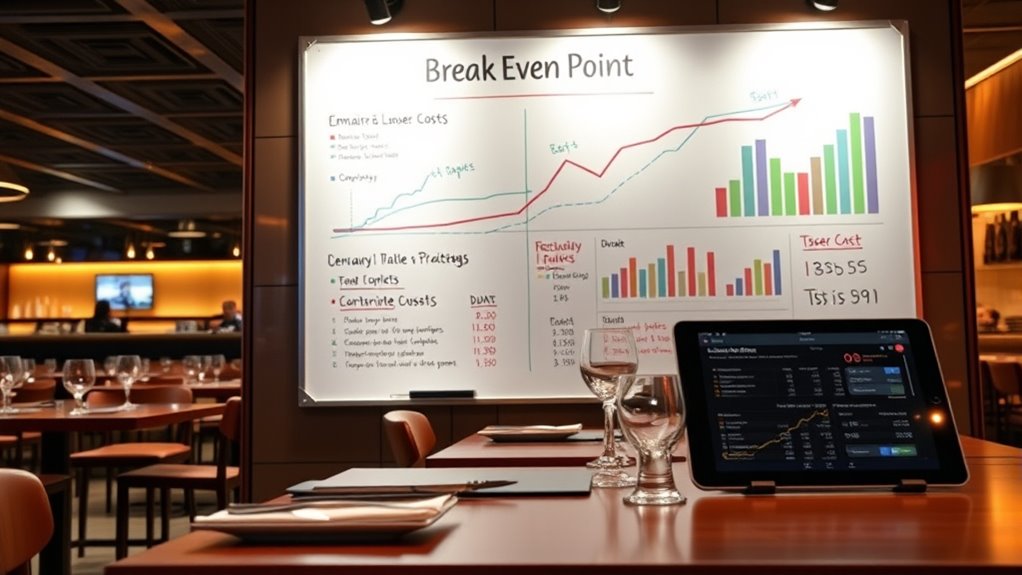
To lower your break-even point and boost profits, consider adjusting your menu pricing strategies to better reflect costs and customer demand. Cutting fixed operating costs can free up funds, making it easier to turn a profit sooner. Additionally, increasing sales volume through marketing or promotions helps spread fixed costs over more units, improving overall profitability.
Optimize Menu Pricing Strategies
Are you looking for ways to boost profitability by adjusting your menu prices? Optimizing your pricing strategy can lower your break-even point and increase profits. Start by analyzing your food costs and customer willingness to pay. Consider offering value-based pricing for popular dishes and bundling options to encourage higher spend. Use the table below to identify potential price adjustments:
| Dish Category | Current Price | Suggested Price |
|---|---|---|
| Appetizers | $8 | $9 |
| Main Courses | $15 | $17 |
| Desserts | $6 | $7 |
| Beverages | $3 | $3.50 |
| Combo Meals | $20 | $22 |
Adjusting prices strategically helps cover costs better, attract customers, and reduce the break-even point without sacrificing volume.
Reduce Fixed Operating Costs
Ever wonder how cutting fixed operating costs can substantially boost your restaurant’s profitability? By trimming expenses that remain constant regardless of sales, you lower your break-even point and increase profit margins. Focus on areas like rent, utilities, and salaries to find savings without sacrificing quality or service. You might consider renegotiating lease terms or switching to more affordable suppliers. Additionally, evaluate staff schedules to ensure efficiency, switch to energy-saving equipment, and minimize waste to cut utility costs. Regularly reviewing contracts helps identify opportunities for better rates. Remember, small adjustments in fixed costs can lead to significant improvements in your bottom line, giving you more financial flexibility and a stronger foundation for growth.
Boost Sales Volume
Want to lower your restaurant’s break-even point? Boost your sales volume by attracting more customers and encouraging repeat visits. Focus on improving your marketing efforts, such as local advertising, social media campaigns, and special promotions, to draw in new patrons. Enhance your menu to include popular or unique items that appeal to your target audience. Consider offering discounts or loyalty programs to incentivize repeat business. Optimize your service efficiency to turn tables faster and serve more guests daily. Partner with delivery platforms to reach a broader customer base. The more customers you serve, the faster you cover fixed costs, lowering your break-even point. Consistent sales growth directly increases profitability, helping your restaurant thrive long-term.
Frequently Asked Questions
How Often Should a Restaurant Review Its Break-Even Analysis?
You’re wondering how often to review your break-even analysis. It’s best to do this regularly, especially when your costs, menu prices, or sales volume change. Typically, you should check it monthly or quarterly to stay on top of your financial health. This way, you can quickly adjust strategies, control expenses, and ensure your restaurant remains profitable. Staying proactive helps you adapt to market shifts and maintain steady growth.
What Are Common Mistakes When Calculating Break-Even Points?
Did you know that nearly 60% of new restaurants fail within the first year? When calculating break-even points, you might overlook fixed costs or underestimate variable expenses, leading to inaccurate results. Avoid common mistakes like using outdated data or ignoring seasonal fluctuations. You should double-check all figures regularly, ensuring your analysis reflects current conditions. Accurate calculations help you make smarter decisions, increasing your chances of long-term success.
How Does Seasonality Affect Break-Even Analysis?
Seasonality impacts your break-even analysis by causing fluctuations in sales and costs throughout the year. You might find yourself with higher expenses during off-peak periods or lower revenue in slow seasons. To stay accurate, you should modify your sales forecasts and cost estimates for different seasons. This way, you can better plan your cash flow, set realistic goals, and ensure your restaurant remains profitable year-round.
Can Break-Even Analysis Predict Long-Term Profitability?
Sure, you can dream about predicting long-term profits with a single number, but that’s like betting on a rollercoaster’s final loop. Break-even analysis gives you a snapshot, not a crystal ball. It helps you understand when you’ll cover costs, but future profits depend on market shifts, customer loyalty, and innovation. So, don’t rely solely on it; plan for the long game with ongoing analysis and flexibility.
How Do External Factors Influence Fixed and Variable Costs?
External factors like economic conditions, competition, and supplier prices directly impact your fixed and variable costs. For example, a recession might increase your costs as suppliers raise prices, while new competitors could force you to spend more on marketing. You need to stay aware of these influences because they can change your costs unexpectedly, affecting your break-even point and overall profitability. Adjusting your strategies helps you stay resilient against external pressures.
Conclusion
Mastering your break-even point is like having a secret weapon that can turn your restaurant into a profit-generating machine overnight. By understanding costs, setting smart sales targets, and tweaking your prices, you’ll release a financial superpower. Don’t just aim to survive—aim to dominate the culinary world! With these strategies, you’ll crush your break-even point so effortlessly, you’ll wonder if your restaurant’s secretly a money-making wizard. Get ready to conquer the food industry!








